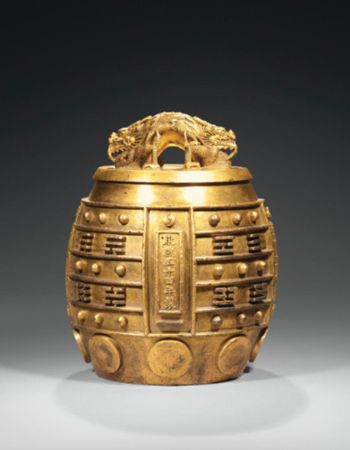Cloche impériale en bronze doré, bianzhong. Chine, datée de l'époque Kangxi (1662-1722) et possiblement de la période
Cloche impériale en bronze doré, bianzhong. Chine, datée de l'époque Kangxi (1662-1722) et possiblement de la période. Photo Sotheby's
la cloche surmontée d'une anse formée de deux dragons à cinq griffes entremêlés rugissant, la gueule entrouverte laissant apparaître les crocs, la tête à deux cornes émergeant d'une crinière foisonnante, le corps recouvert d'écailles frémissantes, la cloche à décor de panneaux alternant rivets et trigrammes en relief entrecoupés de quatres cartouches rectangulaires, deux comportant des inscriptions, d'un côté Kangxi wushisi nian zhi (fait pendant la 54ème année du règne de Kangxi) correspondant à 1715, de l'autre wushe rappelant la tonalité musicale (11ème ton), les deux autres cartouches agrémentés de motifs archaïsants surmontés d'une tête de ruyi; 31 cm, 12 1/4 in. Estimate 250,000-300,000 EUR
NOTE: Gilt bronze bells of this type, bianzhong, were produced for the court during the Qing dynasty and formed an essential component of Confucian ritual ceremonies at the Imperial altars, formal banquets and processions. They were assembled in sets of sixteen and produced twelve musical tones, with four tones repeated in a higher or lower octave.
The music produced by these instruments was believed to facilitate communication between humans and deities. Cast of equal size but varying thicknesses, these bells were attached to tall wooden frames in two rows of eight, as depicted by Guiseppe Castiglione (1688-1766) in his painting Imperial Banquet in Wanshu Garden (c. 1755), included in the exhibition Splendors of China's Forbidden City. The Glorious Reign of Emperor Qianlong, The Field Museum, Chicago, 2004, cat. no. 101.
Four sets of bells of this form appear to have been created during Kangxi's reign; the first two sets in the 52nd year (1713) and the second two sets in the 54th year (1715), and are believed to have been made for the Temple of Agriculture in Beijing. A closely related bell, of the same wushe (fifth) tone and year of manufacture, was sold at Christie's Hong Kong, 26th April 1999, lot 520. Several bells from the 1715 sets have been offered at auction; one of huangzhong (first) tone was sold in our Hong Kong rooms, 7th October 2010, lot 2105; a yingzhong (twelfth) tone bell was sold in our Hong Kong rooms, 8th April 2010, lot 1858; a pair, of yingzhong and ruibin (seventh) tones, was sold at Christie's Hong Kong, 1st December 2009, lot 1942; two sets of five bells, formerly in the Audrey B. Love collection, were sold at Christie's New York, 20th October 2004, lots 455 and 456; and another of taicu (third) tone was sold intaicu (third) tone was sold in our New York rooms, 19th March 1997, lot 25.
For bells from the set dated to 1713, see one sold in our New York rooms, 24th April 1975, lot 240; and two sold in our Hong Kong rooms, 9th October 2007, lot 1327, and the other, 17th May 1979, lot 454.
Sotheby's. Arts D'Asie. Paris | 15 Dec 2011 www.sothebys.com

/https%3A%2F%2Fprofilepics.canalblog.com%2Fprofilepics%2F1%2F0%2F100183.jpg)
/https%3A%2F%2Fstorage.canalblog.com%2F03%2F02%2F119589%2F96711876_o.jpg)
/https%3A%2F%2Fstorage.canalblog.com%2F11%2F31%2F119589%2F94773502_o.jpg)
/https%3A%2F%2Fstorage.canalblog.com%2F20%2F83%2F119589%2F94772815_o.jpg)
/https%3A%2F%2Fstorage.canalblog.com%2F26%2F72%2F119589%2F75604929_o.jpg)
/https%3A%2F%2Fstorage.canalblog.com%2F59%2F60%2F119589%2F26458628_o.jpg)



/http%3A%2F%2Fstorage.canalblog.com%2F40%2F55%2F119589%2F127018399_o.jpeg)
/http%3A%2F%2Fstorage.canalblog.com%2F97%2F70%2F119589%2F122219042_o.jpg)
/http%3A%2F%2Fstorage.canalblog.com%2F56%2F57%2F119589%2F122218368_o.jpg)
/http%3A%2F%2Fstorage.canalblog.com%2F09%2F33%2F119589%2F121095122_o.jpg)